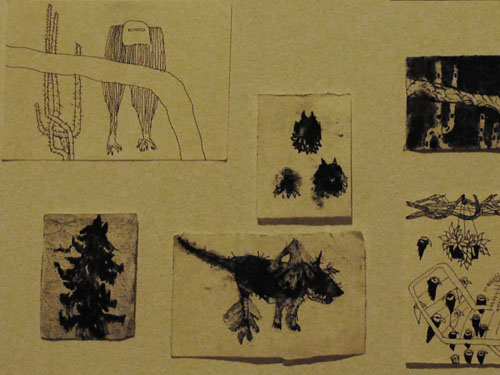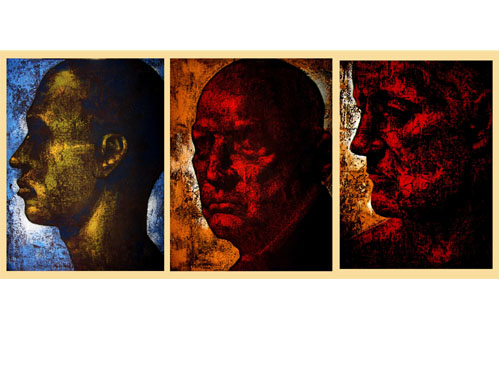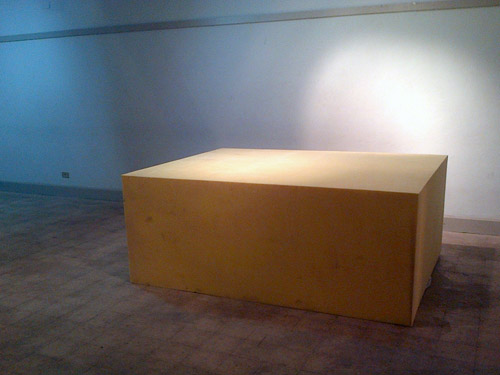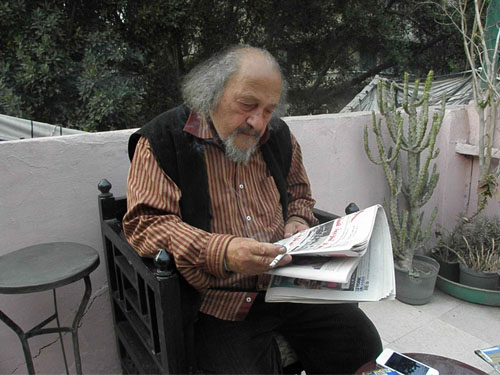
Childish fear was the emotion that artist Noura Seif sought to evoke with “Boody,” a collection of drawings and sculptures installed in the back room of the Contemporary Image Collective’s exhibition space as part of PhotoCairo 5 over the past month.
The feeling crumbles up the spine as we move closer to the detailed hand drawings of boogeymen and plants morphing into black monstrous creatures. Whether the frames — similar to the illustrations in a youngsters’ comic book or an animated horror film — are close-ups of a scene or show open landscapes, feelings of psychological entrapment remain. But the experience is still fun, like going into one of the Brothers Grimm’s horror fairytales many of us grew up reading.
At the center of the exhibition room stood two miniature sculptures of Boody on a wooden pedestal. Boody, after whom the installation is titled, was a shaggy, scary-looking street dog that Seif’s grandmother took in many years ago to save from bullying school children. Modeled with spines similar to a cactus, the two wolf-like beasts cast their shadows on the room’s walls.
Visitors, however, had to walk through the installation like scavengers, closely looking for the little details scattered in the vast room to really see the work. Next to a small plant in one corner was a clay sculpture of a pseudo-monstrous tree. On an adjacent wall, hung a photograph of the tree after which it was modeled, which was also echoed in other sketchbook-like drawings on walls.
The room allocated to exhibit Seif’s work was ultimately too vast for the intimate emotional experience she sought to create, but the work was too interesting to overlook as she introduced more and more fictional characters with each drawing and sculpture, helping viewers make up their own stories.
Seif was one of four early-career artists who enrolled in an intensive mentorship program led by visual artist Doa Aly to create works for PhotoCairo 5. Through one-on-one meetings, Aly worked with the artists to dig deeply into their memories and sources of inspiration. The technique was a success for the four artists, as they said at a symposium organized by PhotoCairo 5 last month. The process was fluid and spontaneous although the production time allowed in the end was somewhat tight and rushed, according to Seif.
“Boody” was inspired by games that Aly initiated in her meetings with Seif to “trace her memory.” Over the course of the weekly meetings, Seif realized that most of her recollections were related to childhood associations with plants and trees in her grandparents’ garden. There was one tree for instance that took the shape of a wolf — the same tree of which there was a sculpture and photograph in the exhibition. As a child, Seif used to ask for this tree’s permission every morning before she went out to play in the garden. Boody, the family’s dog was another recurring element in her memories.
Those conversations and memories were what triggered Seif’s drawings; then came the sculptures, which were another manifestation of the creatures, and they, in turn, inspired more details in the drawings. The path Seif intuitively undertook to make the work is similar to that of a filmmaker, creating a mood through character-building, and constructing an image by assembling the various elements.
The personal stories are not so important however, she argues. It is the feeling that the visuals evoke to viewers that define “Boody.” And on that level, the artwork was successful — and possibly would have been even more so had more thought been given to its installation.
This piece was originally published in Egypt Independent's weekly print edition.




